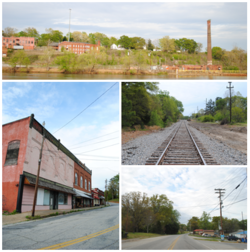Piedmont | |
|---|---|
 Top, left to right: Ruins of the Piedmont Number One overlooking the Saluda River, Main Street, Railroad, Piedmont Highway | |
 Location of Piedmont, South Carolina | |
| Coordinates: 34°42′27″N82°27′54″W / 34.70750°N 82.46500°W | |
| Country | United States |
| State | South Carolina |
| Counties | Anderson, Greenville |
| Area | |
• Total | 8.78 sq mi (22.73 km2) |
| • Land | 8.59 sq mi (22.26 km2) |
| • Water | 0.18 sq mi (0.46 km2) |
| Elevation | 768 ft (234 m) |
| Population | |
• Total | 5,411 |
| • Density | 629.5/sq mi (243.04/km2) |
| Time zone | UTC-5 (Eastern (EST)) |
| • Summer (DST) | UTC-4 (EDT) |
| ZIP code | 29673 |
| Area codes | 864, 821 |
| FIPS code | 45-56365 [4] |
| GNIS feature ID | 2403407 [2] |
Piedmont is a census-designated place (CDP) along the Saluda River in Anderson and Greenville counties in the U.S. state of South Carolina. The population was 5,411 at the 2020 census. [5]
Contents
- History
- Geography
- Demographics
- 2020 census
- 2000 census
- Arts and culture
- Education
- Notable people
- In popular culture
- References
Piedmont is a part of the Greenville-Anderson metropolitan area.


